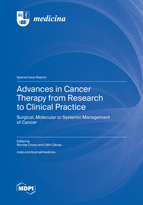Advances in Cancer Therapy from Research to Clinical Practice—Surgical, Molecular or Systemic Management of Cancer
A special issue of Medicina (ISSN 1648-9144). This special issue belongs to the section "Oncology".
Deadline for manuscript submissions: closed (31 March 2023) | Viewed by 82796
Special Issue Editors
Interests: oncological surgery; urology; cancer
Special Issues, Collections and Topics in MDPI journals
Interests: cancerogenesis; chemotherapy; miR
Special Issues, Collections and Topics in MDPI journals
Special Issue Information
Dear Colleagues,
Cancer remains one of the most challenging diseases from epidemiologic, clinical and therapeutic perspectives. The rhythm of changes in various aspects of the oncological disease, the molecular characterization of new subtypes of classical primary-type tumors, new pathways in cancerogenesis and new classes of therapeutical agents makes it very difficult to follow all relevant findings in this research field. Most significantly, what remains are the personal clinical observations and experiences of each of us. We all know very well of the level of trust required in these things, but we remain doctors who treat real-life patients, not those selected for a clinical trial.
We invite you to participate in this Special Issue of Medicina, in order to facilitate the presentation of your research or institutional experience of treating cancer patients. Your clinical experience and research ideas represent a very precious tool for each of every one of us.
Prof. Dr. Nicolae Crisan
Prof. Dr. Călin Căinap
Guest Editors
Manuscript Submission Information
Manuscripts should be submitted online at www.mdpi.com by registering and logging in to this website. Once you are registered, click here to go to the submission form. Manuscripts can be submitted until the deadline. All submissions that pass pre-check are peer-reviewed. Accepted papers will be published continuously in the journal (as soon as accepted) and will be listed together on the special issue website. Research articles, review articles as well as short communications are invited. For planned papers, a title and short abstract (about 100 words) can be sent to the Editorial Office for announcement on this website.
Submitted manuscripts should not have been published previously, nor be under consideration for publication elsewhere (except conference proceedings papers). All manuscripts are thoroughly refereed through a single-blind peer-review process. A guide for authors and other relevant information for submission of manuscripts is available on the Instructions for Authors page. Medicina is an international peer-reviewed open access monthly journal published by MDPI.
Please visit the Instructions for Authors page before submitting a manuscript. The Article Processing Charge (APC) for publication in this open access journal is 2200 CHF (Swiss Francs). Submitted papers should be well formatted and use good English. Authors may use MDPI's English editing service prior to publication or during author revisions.
Keywords
- cancer
- systemic therapy
- surgery
- molecular
- research
Benefits of Publishing in a Special Issue
- Ease of navigation: Grouping papers by topic helps scholars navigate broad scope journals more efficiently.
- Greater discoverability: Special Issues support the reach and impact of scientific research. Articles in Special Issues are more discoverable and cited more frequently.
- Expansion of research network: Special Issues facilitate connections among authors, fostering scientific collaborations.
- External promotion: Articles in Special Issues are often promoted through the journal's social media, increasing their visibility.
- Reprint: MDPI Books provides the opportunity to republish successful Special Issues in book format, both online and in print.
Further information on MDPI's Special Issue policies can be found here.








